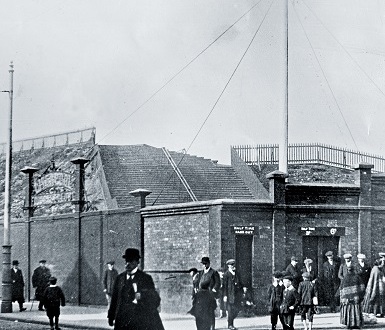How a part of Brunel’s Great Eastern ended up at Liverpool FC
At the South Eastern tip of Millwall near Canary Wharf in the East End of London lie the remains of the SS Great Eastern’s launch ramp. Designed by Isambard Kingdom Brunel, the SS Great Eastern was no ordinary ship, it was a structure so magnificent people paid just to walk around it. The ship was a massive 22,500-tons and nearly 700 feet in length and was so far ahead of its time that that it would be nearly four decades before the world would see a ship of this magnitude.

Brunel was the greatest engineer of his time, best known for the Clifton Suspension Bridge and the building of the Great Western Railway, connecting London to New York via Bristol and designing a ship which would ferry passengers from Bristol to New York, the Great Western at that time was the largest ship ever built.
Originally called the Leviathan, the Great Eastern had problems from the outset, on the day of her launch in front of 3000 paying customers she failed to launch, she was positioned sideways on iron rails to supposedly make the launch easier but due to technical difficulties she failed to enter the Thames, it would be another three months before the ship entered the Thames, much to the embarrassment of Brunel. After being fitted out at Deptford, the ship was ready for its trials in September 1859.
Sadly Brunel who had made a final inspection visit on board the ship collapsed with a stroke and later died. From the outset the Great Eastern was plagued with ill-luck, with several fatalities during her construction and several more on the day of her botched launch. In September 1859, the ship was on her maiden voyage in the English Channel when she suffered a major explosion to one of her funnels and another five men were killed.
The Great Eastern struggled to find enough passengers on both the Australian or American route and as a consequence the company liquidated, the ship was put up for sale in 1864, with no one willing to purchase this magnificent vessel she was chartered to the Telegraph Construction Company, for the purpose of laying the first transatlantic telegraph cable.
After the world’s first submarine telegraph cable was laid connecting Dover with Calais in France in 1851 and a longer connection was laid linking Britain and Ireland. The next big target was North America where an attempt to lay a cable across the Atlantic in1858 was initially successful but unfortunately the signal only lasted a week, this however proved that it was technically possible.
The Great Eastern was the only ship big enough to take the length of cable required for this huge operation, and it took five months just to load it. The first voyage of the new venture took place on 14 July 1865 to connect the 2600 miles of cable between Valentia Island, County Kerry and Newfoundland and although this too proved unsuccessful due to machinery hitches, plans were immediately in place for another attempt the following year in which this proved successful. For the next few years the Great Eastern went on to successfully lay many more submarine cables in many parts of the world, by 1872 she became redundant in this role after the introduction of purpose built cable-laying ships and spent the next 12 years laid up at Milford Haven on the South West Coast of Wales.
In 1885 the now redundant Great Eastern was transferred to the River Mersey and turned into a music hall and fun fair by the department store Lewis’s at a shilling a head, this magnificent structure was also used by Lewis’s as a giant billboard. After exhibition trips to Dublin and the River Clyde she returned to the River Mersey and in 1888 she was auctioned off.
This once great structure that played such a major role in the history of world communications ended its days at the mercy of the breakers, who took 2 years to dismantle her. 200 men worked on her consuming a total of 3.5 million man hours. Apparently skeletal remains were found inside the double hull of the ship, this would have occurred during the construction of the ship.

However, this was not the end for all of the Great Eastern due to the fact that the owners of Everton FC, who were then the custodians of Anfield, where Liverpool FC play today purchased one of the ship’s masts and placed it close to the Kop end at Anfield. The Great Eastern had 7 masts, each of them being called after the days of the week the one that stands proudly close to the entrance of what is now globally known as the Kop is called the Thursday mast
Liverpool FC was formed in 1892 and the original occupants Everton FC moved across Stanley Park to Goodison. Liverpool FC and its fans can proudly boast that they have a rare piece of history, a tribute to the greatest engineer Britain has ever known – Isambard Kingdom Brunel, architect of the SS Great Eastern.
https://londonerwalking.wordpress.com/2015/08/05/how-a-part-of-brunels-great-eastern-ended-up-at-liverpool-fc/